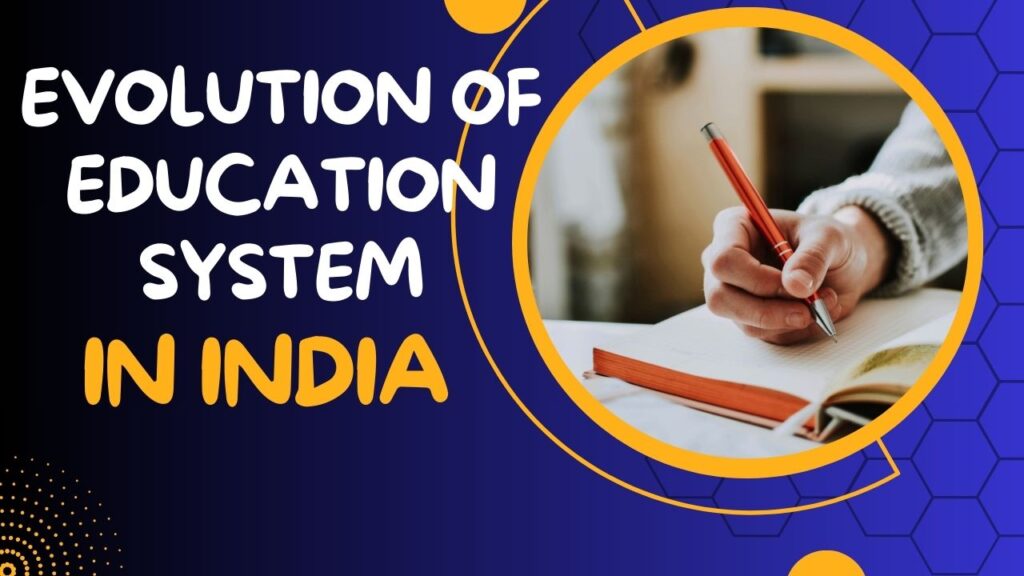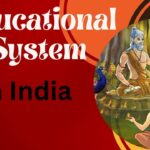Evolution of Education System in India multifaceted journey that spans thousands of years and reflects the country’s rich cultural, social, and historical heritage. The education was mostly imparted in ashrams, gurukuls, temples, houses.


The evolution of education in India is a complex and multifaceted journey that spans thousands of years and reflects the country’s rich cultural, social, and historical heritage. Here’s a brief overview of the evolution of education in India:
1. Ancient Period (Pre-1000 BCE):
– Education in ancient India was primarily transmitted through oral traditions, with knowledge passed down from generation to generation through vedas, upanishads, and other sacred texts.
– Gurukul system: Education was conducted in gurukuls or ashrams, where students lived with their gurus (teachers) and received holistic education encompassing scriptures, philosophy, ethics, sciences, arts, and life skills.
2. Medieval Period (1000-1757 CE):
– Islamic Influence: With the advent of Islamic rule in parts of India, institutions known as madrasas were established to impart religious education and training in Islamic sciences.
– Persian and Arabic languages were emphasized, and subjects such as mathematics, astronomy, medicine, and literature were also taught.
3. Colonial Period (1757-1947 CE):
– British Colonial Rule: The British East India Company and later the British Crown established colonial rule in India. They introduced modern education systems aimed at producing clerks, administrators, and loyal subjects for the British Empire.
– Macaulay’s Minute (1835): Lord Macaulay’s minute recommended the promotion of English education over traditional Indian languages to create a class of Indians anglicized in taste, morals, and intellect.
– Wood’s Dispatch (1854): This dispatch laid the foundation for the modern education system in India, emphasizing the need for mass education, establishment of schools, and promotion of vernacular languages alongside English.
4. Post-Independence Period (1947 onwards):
– Indian Constitution: The Indian Constitution recognized education as a fundamental right and placed the responsibility of providing free and compulsory education for children aged 6-14 on the state.
– Sarva Shiksha Abhiyan (SSA): Launched in 2001, SSA aimed at universalizing elementary education and improving the quality of education in India.
– National Policy on Education (NPE): The Government of India has periodically introduced national policies on education to address the evolving needs of the education sector. Notable policies include the NPE 1968, NPE 1986, and the recent National Education Policy (NEP) 2020, which emphasizes holistic and multidisciplinary education, integration of technology, and skill development.
5. Modern Trends and Challenges:
– Rapid expansion of educational institutions, including schools, colleges, universities, and technical institutes.
– Emphasis on STEM education, vocational training, and skill development to meet the demands of a globalized economy.
– Challenges include disparities in access to education, quality issues, high dropout rates, gender disparities, and the digital divide between urban and rural areas.
The evolution of education in India reflects a blend of indigenous traditions, colonial legacies, and contemporary reforms aimed at creating an inclusive, equitable, and knowledge-based society. While significant progress has been made, ongoing efforts are needed to address persistent challenges and ensure that education serves as a catalyst for individual empowerment, social development, and national progress.
Technological improvement has boosted the economic growth in India. Science and technology have an important role in the economic development of India.
Compared to other developed countries, India has more youth manpower. Proper education will play a significant role in making youth future-ready and increasing economic growth by providing skilled persons which will also boost industrial development. In the modern era of education, every institution or university is adapting new teaching methods using their teaching methodologies. Indian education is the biggest and well-known education systems in the world. During ancient education, there were 5 big well-known universities like Takshashila, Nalanda, Vallabhi, etc., which focus on the all-round development of students. In modern education, there are well known autonomous institutes like IITs, IIMs, AIIMS which are famous all around the world.
During ancient education, students live away from their parents, their education comprises of subjects like physical education, mental education, politics, economics, etc. They were shaped in a way that they can live in any condition considering how difficult the situation will be? Medieval education also followed the same protocol as ancient education in spite that their education mostly focuses on religion. In today’s modern era of big institutes like the Indian Institute of Technology (IITs) and Indian Institute of Management (IIMs), everything is changed like the living standard of students, curriculum, all-round development. The principle objective of the student has been to just achieve its goal and be successful.
Only the big institutes like IITs, IIMs, AIIMS and some other private and aided universities have adopted modern methods of learning. There is a difference in curriculum, teaching methods, and living standards of students in every institute. The syllabus of the current education system is not industry-oriented and also not according to new upcoming trends. The main objective of education is mostly theoretical and not practically implemented.
The main purpose of this article is to convey what all the things need to adopt in our current education system from ancient and medieval times and also some new trends associated with it. The paper is mainly categorized into three sections Ancient, Medieval and Modern education system, including sub-sections such as curriculum, method of learning, the aim of education, characteristics of education, educational institutes, higher educational institutes, advantages, and disadvantages of the particular education system.
Ancient education
During the ancient period, two systems of education were developed, Vedic, and Buddhist. The medium of language during the Vedic system was Sanskrit, while those in the Buddhist system were Pali. During those times the education was of Vedas, Brahmanas, Upnishads, and Dharmasutras. From the Rigveda onwards, our ancient education started with the objective of developing the students not only in the outer body but also on the inner body. The ancient education focused on imparting ethics like humility, truthfulness, discipline, self-reliance, and respecting all creations to the students.
The education was mostly imparted in ashrams, gurukuls, temples, houses. Sometimes pujaris of the temples used to teach students. The education system of ancient India has some special features and uniqueness which was not found in any other ancient education system of the other countries. The education was mostly given in forests under the blue sky, which keeps the student’s mind fresh and alive. During ancient times people used to live a simple life and doing their work with devotion and hard work.
Aim of education
The main objective of education was to equip the students with a good quality of education. The education mostly focused on the enrichment of culture, character, and personality, development, and cultivation of noble ideals. The objective was gaining the mental, physical, and intellectual personality of students, to make the students future-ready and survive in any situation.
Characteristics of education
During the ancient period, the state government and the people did not interfere in designing curriculum, payments of fees, regulation of teaching hours. There was a strong bonding between teacher and student. Every student was allotted with one teacher and more emphasis was given to the student-teacher relationship, each student used to meet teachers personally to learn and gain instructions from them. During ancient times, royal families, as well as kings of states, used to donate their wealth to improve the education system and quality.
The syllabus was designed in accordance with the demands of that era. At that time students used to leave their houses and went to live with their gurus until their education was completed. During the early Vedic period, women’s education was also given more emphasis. The education focuses on the physical and mental development of students. The course duration was about 10–12 years, as there were no books so students used to memorize all things, memory played a crucial role during learning. The education was imparted in forests away from cities and peoples to give students a pleasant and silent environment of study.
Curriculum
Curriculum plays an essential role in the education system. It was dynamic and not static; it was made up of different stages. The fundamental goal of building a good curriculum was to develop students physically and mentally. The curriculum consists of four Vedas, six vedangas, Upnishads, darshanas, Puranas, Tarka Shastra. The six vedangas were Shiksha, Chhandas, Vyakarana, Nirukta, Jyotisha, and Kalpawhile the darshanas were Nyaya, Baiseshika, Yoga, Vedanta, Sankhya, Mimasa. Algebra, Geometry, and grammar were also given more importance at that time.
Panini was famous in the domain of grammar at that time. The curriculum of the Buddhist system consists of pitakas, Abhidharma, and sutras. Besides this medicine, Vedas were also given importance. Hindu learning was a part of Buddhist learning, although more emphasis was given to Buddhist learning. Both the systems were going hand in hand at that time. The education was totally through orals and debates, and the exams were conducted every year. The education system of the ancient period focused on subjects like warfare, military, politics, religion.
Methods of learning
The teachers at that time paid special focus to their students and teach them according to their knowledge and skill level. Teaching was basically via orals and debates, and the different methods were as follows:
At that time books were not there, so students had the habit to learn and memorize all the things taught in the class, and teachers also helped them in memorizing. The students used to deep dive into the concepts taught by their teachers and explore new methods to learn it.
Listening, Contemplation, and concentrated contemplation were some new methods of exploring the way of learning.
The teachers used the storytelling methods to teach the student.
Students used to ask questions about the topics taught by the teachers and these topics were discussed and then answered to the students.
The education of that time mainly focused on practical knowledge of the topics taught in the class.
The students got plenty of knowledge through seminars and debates conducted at frequent intervals.


Dr. Vivek Kumar Jha
Prof. and H.O.D
Department of Audiology and Speech Language Pathology
Faculty of Allied Health Sciences,
Shree Guru Gobind Singh Tricentenary University,
Gurugram, Haryana.











